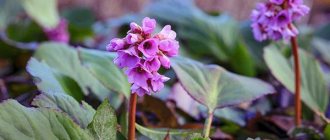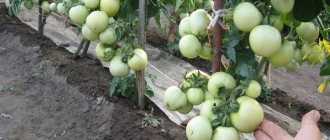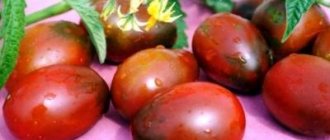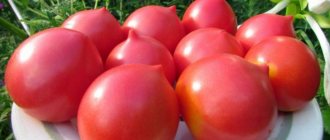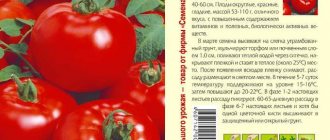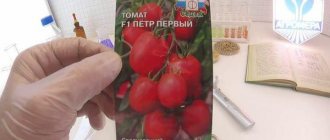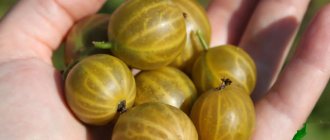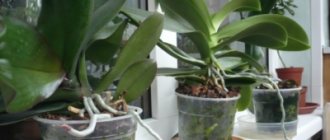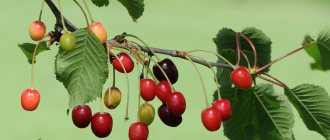“Big Boy” is part of a small “family” of peppers that was bred by domestic agriculture. A whole palette of the most variegated colors is represented by Russian peppers - red and yellow-orange “Big Mama” and “Big Girl”, deep purple “Big Daddy” and, of course, bright red or green-blue “Big Boy”. Today you cannot hear a single negative review about “Big Boy”. Thanks to the excellent taste and rich content of a complex of vitamins in pepper fruits, every gardening enthusiast is happy to purchase Big Boy seeds from a successfully proven manufacturer.
Description and characteristics of the Big Boy variety
Big Boy pepper is a product of Russian breeders from, who released a series of large-fruited varieties of different colors. It was included in the State Register of the Russian Federation in 2012. The originator recommends it for growing outdoors, in greenhouses and in film shelters.
Big Boy's bushes are strong, not too spreading, and medium in height. The leaves are medium in size, dark green in color, and characterized by slight wrinkles.
Did you know? Pepper has been a literally valuable product since ancient times. They were paid as money and fines were paid. Thus, it is known that residents of the French city of Beziers were ordered to pay a fine of 3 pounds of pepper for the death of the Viscount.
The fruits are very large, reaching a weight of 250–300 g. Their shape resembles a cylinder. The skin is dense, shiny, dark red in color. The taste of the peppers is excellent. They are sweet and juicy. There is no bitterness in them. The content of valuable elements is very high. The fruits are well stored and do not lose their presentation after transportation.
Why Big Boy?
Bell peppers from the Bigov family are the preferred variety not only for home cultivation, but also for harvesting on an industrial scale. It has the characteristic taste of bell pepper with pronounced features, which provide it with a large amount of vitamins and juicy, sweet pulp with a standard skin.
It is indispensable for fresh consumption, as an integral part of the diet for many diseases, and is perfect for culinary needs and canning in the form of multi-component canned food. As a crop to grow, it also has its own pleasant features:
- fairly large fruits;
- pepper wall up to 9 mm thick;
- resistance to weather conditions, especially in comparison with imported hybrids;
- high level of fruit set;
- the ability to maintain its presentation for a long time;
- excellent yield;
- seed material from a trusted supplier with an excellent reputation;
Every year a large number of new varieties appear, which are difficult for the amateur gardener to understand. But consumer reviews and seed sales ratings say that more and more people prefer domestic production, which provides an affordable opportunity to purchase fresh planting material.
Advantages and disadvantages of the variety
- The advantages of Big Boy include:
- fruits ripen early;
- forms tasty and large peppers;
- shows consistently high productivity;
- tobacco mosaic resists viral disease well;
- the fruits are suitable for universal culinary purposes;
- Peppers are stored for a long time and tolerate transportation well.
Of the shortcomings, only one can be highlighted - weak immunity. Peppers must be protected from major diseases common to the nightshade family.
Features of crop cultivation techniques
High yields can only be achieved from a plant that is planted and grown taking into account the recommendations. Before you start planting peppers, you should choose a good site, healthy and high-quality planting material and grow strong seedlings.
Also learn about sweet pepper varieties such as Tusk and Gipsy.
Seed selection and preparation
Seeds need to be prepared in a special way for planting.
Preparation will consist of the following stages:
- Treatment in a solution of potassium permanganate for 20–30 minutes.
- Rinse under running water.
- Soaking in a nutrient solution to improve germination, prepared according to one of the recipes: nitrophoska (1 tsp) + 1 liter of water (procedure duration - 24 hours); wood ash (1 tsp) + 1 liter of water (duration - 24 hours); liquid solution of sodium humate (duration - 24 hours, liquid temperature - +25...+28°); drug “Ideal” (duration - 24 hours, liquid temperature - +25...+28°); "Azotofit" product, 5-10 ml / 0.5 l of water (duration - 2 hours).
- Germination.
Germination is carried out as follows:
- Place a cloth at the bottom of a flat container.
- Moisten it and pour it with an aqueous solution of wood ash (1 tbsp. / 1 l).
- Sprinkle the seeds onto a damp cloth.
- Cover the container with film or glass.
- Place in temperature conditions +25…+30°С.
- Periodically moisten the seeds with a spray bottle.
Germination should occur after 1–2 weeks.
Strong seedlings can be grown if you harden the seeds. To do this, they are first placed on the bottom shelf of the refrigerator for 48 hours, and then transferred to a temperature of +18°C for 24 hours. Then the seed is put back into the refrigerator. After 2 days they are sown in the ground.
Preparing the soil for seedlings
The key to growing strong seedlings is the preparation of high-quality soil. It should be light and loose so that nutrients can quickly and easily reach the roots.
The substrate can be purchased ready-made in a specialized store or made with your own hands by mixing the following components:
- Humus (2 parts) + turf soil (1 part).
- Peat with humus (in a ratio of 1 to 1).
- Nutrient peat mixture (2 parts) + turf soil (1 part).
- Peat (4 parts) + turf soil (2 parts) + humus (1 part) + rotted sawdust (1 part).
The substrate, prepared with your own hands, requires disinfection.
Soil etching is carried out using several methods:
- Water with a dark pink solution of potassium permanganate.
- Pour boiling water over it.
- Keep in the oven at a temperature of 80–90° for 20–40 minutes.
- Place in a steam bath for 40 minutes.
- Place in the microwave on maximum mode for 10 minutes.
The treated soil is left to sit for a couple of weeks so that it becomes populated with beneficial bacteria. Immediately before planting, it is well moistened.
We recommend reading about the varieties and characteristics of growing indoor peppers.
Timing of sowing seeds
Seeds are planted in the ground in late February - early March. In this case, planting sprouts in the ground can be done at the end of April in a heated greenhouse and in May in an unheated shelter, at the beginning of June - in open ground.
For growing seedlings, use a long box or separate containers measuring 10 x 10 (plastic cups, peat pots, tablets, cassettes). The latter option is preferable, since in this case there is no need to pick, which can lead to damage to the delicate roots.
In one large container, the seeds are sown in furrows to a depth of 1–1.5 cm. A distance of 3–4 cm is left between the furrows. In separate containers, make 2 holes 1–1.5 cm deep and place 1 seed in them. The seeds are sprinkled with soil. The containers are covered with film or glass. Then they are placed in a warm room.
Features of caring for seedlings
When seedlings appear, the cover must be removed. In the first week after this, the seedlings are grown at a temperature of +13...+16°C during the day and +8...+10°C at night. Then they are returned to warm conditions with a temperature range of +20...+27°C.
Seedlings should be moistened once a week. Watering should be plentiful. It is important to ensure that drops do not fall on the stems and leaves. When grown in one box, picking is done when 2–4 leaves appear. Seedlings are planted in separate containers with a volume of 0.5 liters.
Fertilizers are applied 14 days after picking. Use a mixture of superphosphate (50 g) with urea (5 g) and water (10 l). The second application is carried out 3-4 days before moving the sprouts to a permanent place. At this time, add a mixture of superphosphate (50 g) with potassium sulfate (25 g), diluted in a bucket of water. Ready-made fertilizers are also quite suitable, for example, “Agricola”, “Mortar”, “Krepysh”.
Before planting the sprouts in the ground, they must be hardened off. The hardening procedure begins 10–15 days before the planned date of planting at a permanent place of growth. First, the sprouts are kept with the window open, then taken out into fresh air, starting from 40 minutes a day. Gradually this time is increased to 6–8 hours. Immediately before landing, they are left to spend the night outside.
Important! When carrying out the hardening procedure, it is necessary to shade the sprouts from sunlight.
Landing in the ground
The sprouts are transferred to the ground at the age of 50–70 days. At this time, the stems should reach a height of 20–30 cm, with at least 6–8 leaves growing on them. Planting is carried out when the outside temperature reaches +15...+17°C.
For planting, a 35 x 50 cm pattern is used. Choose a well-lit area, sheltered from the winds.
Holes are made in the prepared soil. Their depth should be such that the root collar of the sprout is at soil level when planting. Add 1 tbsp to each well. l. complex mineral fertilizer. The sprouts are moved into the holes without destroying the earthen coma. After the hole is half filled with soil, it needs to be watered. Use 3–3.5 liters of water per hole. After the water has been absorbed, the soil is poured to the top.
The planting process is completed by mulching the soil and, if necessary, tying it to the supports. If the temperature is predicted to drop below +13…+14°C, shelter will be provided for planting. The first 2-3 days will also require shelter from aggressive sunlight.
Important! Successful growth, development and productivity of pepper depend on compliance with the rules of crop rotation. This crop should not be planted after potatoes, peppers, tomatoes, and eggplants. The best predecessors are pumpkin, cabbage, and legumes.
Caring for the variety after planting in the ground
Pepper cannot be called a capricious plant, but it still requires regular care. Without it, the fruits will be small, the bushes will be weak, susceptible to pathogens and attacks by harmful insects. In order for plants to grow well and develop properly, it is necessary to carry out scheduled moistening, fertilizing, hilling, soil care, pinching and staking.
Watering and fertilizing
Peppers like to be moistened frequently, but not abundantly. It would be ideal if you can organize drip irrigation for it. The recommended frequency of moisturizing is once a week. Only warm water is used for irrigation.
From top dressing, green fertilizer is applied every 2 weeks before fruiting. After the ovaries are formed, it will be necessary to apply phosphorus- and potassium-containing fertilizers. Peppers can also be fed with complex mineral fertilizer with a low nitrogen content.
Hilling and loosening the soil
Hilling is not a mandatory procedure for peppers. Today there is no consensus on whether this culture needs it or not. Many gardeners advise producing it in order to stimulate the formation of additional roots and improve the growth and development of the plant. Adherents of a different point of view believe that this procedure is harmful to peppers, as it increases the risk of root rotting.
Whether to hill pepper or not is up to each gardener to decide for himself. If you are a supporter of hilling, then you need to do it carefully due to the close location of the roots. Hill up the pepper until the cotyledon leaves form. A mound of soil is placed near the stem.
Important procedures when growing peppers are loosening, weeding, and mulching. Loosening improves the air and moisture conductivity of the soil. In this way, nutrients will be delivered to the roots faster and better absorbed by them. Loosening for pepper should not be deep.
Also find out whether bell peppers need to be pinched.
With the help of weeding, it is possible to get rid of weeds that take away nutrients from the pepper, protect it from the sun and become carriers of pathogens, as well as harmful insects.
Mulching is done after watering. A layer of straw, peat, and rotted grass is poured between the rows and near the tree trunk. This procedure allows you to maintain an optimal level of soil moisture and prevents the growth of weeds.
Plant Formation
To ensure that the Big Boy pepper receives enough light, it is best to grow it with a garter to a trellis. It is important to take stepson, forming a bush of two stems, removing all the stepsons and leaves to the fork. Removal of stepsons is carried out in the morning on a not too hot day in the absence of precipitation. The shoots are cut off manually.
After the ovaries begin to form, it is necessary to remove the leaves that cover them from the sun, as well as the ovaries themselves, if there are too many of them on the bush. Otherwise, the fruits will form small.
The main thing about the variety
The plant is compact, medium-sized, semi-standard type. The bush is slightly spreading. The leaves are dark green, slightly wrinkled. Drooping fruits during the ripening period give the bush a spectacular appearance.
- The shape is cylindrical.
- The surface is shiny and acquires a bright red color during ripening.
- The fruits are juicy, pleasant taste, without bitterness.
- The size of the peppers on the bushes is even, the average weight is 250-300g.
- Wall thickness is about 8mm.
- The fruits are used universally. They can be used to prepare many dishes, both raw and thermally processed. Perfect for canning, as well as for making ketchup, lecho, and various sauces in combination with other vegetables. Used for freezing.
- The variety is well preserved and transported painlessly.
- Productivity – up to 8 kg per sq.m.
- The high content of vitamin C makes the fruit extremely beneficial, especially for weakened people with low immunity.
Pests and diseases
Unfortunately, Big Boy peppers are susceptible to many diseases, including such dangerous ones as:
- Late blight . It manifests itself as the formation of brown spots on leaves and fruits. To prevent the appearance of fungi that cause this disease, preventive spraying should be done with copper-containing agents, the drug “Fitosporin”.
- Verticillium wilt . It has characteristic symptoms: paleness and drying of the foliage, lethargy of the entire plant. The disease cannot be treated. Diseased bushes must be urgently removed from the site and disposed of by burning. The area should be disinfected.
- Apical rot . It happens when the soil contains low amounts of calcium and high levels of nitrogen. Weeping spots form on the foliage and tops of fruits. The disease is treated by adding calcium nitrate.
- Black leg . The fungus that causes this disease most often infects seedlings and young bushes. To prevent the disease, the soil and seeds are treated with a pink solution of potassium permanganate.
Peppers are threatened by pests such as the Colorado potato beetle, spider mites, and aphids.
that the Colorado potato beetle . This is a large insect with striped wings. Its larvae are also large and pink. They can eat almost all of the foliage. They fight the beetle by treating with insecticides “Calypso” and “Prestige”. In case of minor infestation, insects are collected by hand. To scare them away from planting in the immediate vicinity of eggplants, horseradish, calendula, coriander, and beans are planted.
Spider mites weave webs around leaves and stems. This small red or black sucking insect can be found on the lower leaf blades. It feeds on the juices of the plant, causing the pepper to wither and dry out. Nitrofen, colloidal sulfur, and acaricides are used against ticks: Fufanon, Actellik, Karbofos.
Aphids feed on plant juices. This insect is small, and with a minor lesion it is difficult to detect. Its presence can be indicated by a large accumulation of ants under the bushes and white remains from the shell of hatched larvae. The fight against aphids is carried out by spraying with a soap solution with the addition of ash, using the drug “Strela”.
Harvesting technique and application
If you plan to sell pepper, then it must be harvested at the stage of technical maturity, i.e. at the moment when the fruits reach the weight and size declared by the manufacturer, but will be somewhat lighter in color. It ripens perfectly when picked, while retaining 100% of its commercial qualities. The fruits are collected gradually, every 5–7 days.
For your own purposes, for planting, for seeds, the fruits can be harvested in a state of biological maturity, which occurs after 20–30 days. At this time, the fruits become as juicy as possible, their skin turns dark red.
The pepper must be cut with scissors or pruning shears, leaving the stalk. You should not pick them, as you can damage the stem.
Did you know? The first documentary source that mentions pepper was written 3 thousand years ago in Sanskrit.
Pepper does not last long - about 1–1.5 months. The longest possible storage period is possible in temperature conditions of +8...+10°C, with a humidity of 80–90%. The fruits must be wrapped in paper.
Thanks to its attractive appearance and excellent taste, Big Boy pepper can be used for various culinary purposes. It is great for making fresh salads. It can be stuffed, used for lecho, or preserved for the winter.
So, the Big Boy pepper variety undoubtedly deserves the attention of summer residents and gardeners. It bears delicious fruits, pleases with abundant harvests, and can be used fresh and for winter seaming. People who have already appreciated this pepper speak extremely positively about it.
Growing conditions and benefits
Big Boy is a large-fruited pepper with fleshy fruits that contain a huge amount of vitamins and microelements. Bell peppers are deservedly included in therapeutic diets for exhaustion, recovery from serious illnesses, anemia, tuberculosis and diseases of the hematopoietic system.
It has long been firmly established in the diet of not only residents of the middle zone, but also the northern regions. Eating lettuce peppers, especially fresh, prevents the occurrence of vitamin deficiency and other diseases associated with a lack of vitamins. Hence the increased interest in new varieties released on the domestic market.
Choosing the Big Boy variety for growing bell peppers is a smart step, if only because it is a low-growing, determinate-type plant that has excellent fruit set ability and high resistance to weather conditions and major types of pests. Like any sweet pepper, it prefers heat and moisture when grown and reacts negatively to their deficiency.
But due to its short stature, it spends less time forcing stems and leaves, and produces fruit faster. On average, on loam or sandy soil, with a minimum of required heat and well-drained soil, you can grow up to 8 kg of yield with fruits measuring 160-200 g with a thick wall filled with pulp and juice.
If you provide qualified care - water often, but not abundantly, feed and harden seedlings planted from high-quality seed material, then the harvest can be harvested slightly larger, but the fruits will reach up to 300 g. It is believed that there are more vitamins in fruits of technical ripeness, only that plucked from a bush. Those peppers that are stored for a long time still contain more vitamins than the famous black currants and citrus fruits of unknown freshness that are brought from abroad.
You may be interested in: Favorable days for picking pepper in 2021 according to the lunar calendar Favorable days for planting pepper for seedlings in 2021: terms and rules for sowing at home Favorable days for sowing sweet and bitter pepper for seedlings in 2021
The Big Boy variety is positioned by the manufacturer not only as having beneficial properties, but also as an excellent keeping quality variety that can be preserved for a long time.
Note. Picked in a state of technical ripeness, the Big Boy variety is able to ripen, acquire a red color and ripe properties, and at the same time maintain a 100% attractive presentation.

